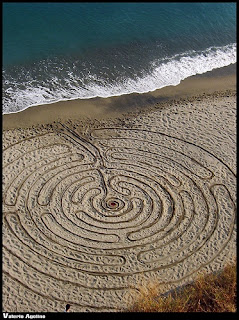Heidi's Visual Research:
A Practice for Presence:
LABYRINTH WALKING
"Labyrinth walking is the practice of journeying to and then returning
from the center. A labyrinth has a clearly marked path to follow, and
is not a maze in which you can get lost. Labyrinths can be thought as
symbolic forms of pilgrimage; you can walk the path ascending towards
salvation or enlightenment.
During the middle ages, labyrinths were built in a number of large
European churches. The full flowering of the medieval labyrinth design
came about during the 12th and 13th centuries with the grand labyrinths
of the gothic cathedrals, most notably Chartres and Amiens in Northern
France and Siena in Tuscany.
There are also remarkable examples of the labyrinth shape from a
whole range of ancient cultures. The symbol has appeared in forms and
media, such as petroglyphs, pavement, grass and basketry, throughout
most parts of the world, from Java, Native North and South America and
Australia, to India and Nepal.
Many labyrinths exist today in churches and parks to provide people
with a meditative way to relieve stress. Labyrinths can now also be
found in retreat centers, hospitals, prisons, parks, airports and
community centers. There are around 2,000 permanent labyrinths in the
United States alone.
Labyrinths may be created with stone, tape, fabric, sticks, chalk,
plants, and many other materials. “Finger labyrinths” are also rising in
popularity, as small wooden or metal plaques on which the labyrinth
pattern is traced with a finger or a stylus."

























No comments:
Post a Comment